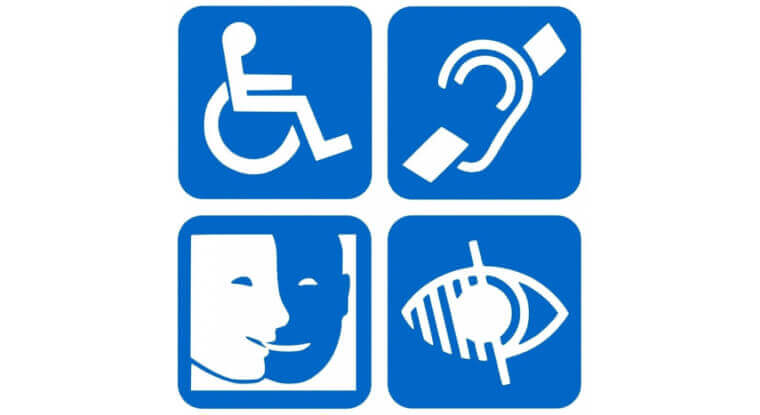Post by: Pedro Velhinho
Pedro is a blind digital marketing professional with more than 13 years of experience writing content, SEO, and, due to his condition, an accessibility trainer. He is currently a coach for Lisbon Digital school in Portugal and some of the biggest agencies in the country.

----------
Have you ever had to climb up a set of stairs with your knee hurting so bad you couldn’t fold your leg? Or have you ever tried to navigate through a living room full of kids’ toys with your eyes closed? Or better still, imagine having to negotiate your way through an unknown city without street signs with your car lights off?
This is how most disabled, older, tech uneducated, and people with special needs feel while using websites or mobile apps that don’t consider accessibility features. We feel lost, we doubt our abilities to navigate the internet simply, and we feel completely dependent on others.
In the next few paragraphs, I will try to explain the importance of digital accessibility in the long-standing fight for inclusion and equality of access to information while conveying my thoughts on how companies should go about automating their processes to make this possible in a fast and cost-friendly fashion, that, ultimately, benefits all.
What is digital accessibility?
Digital accessibility’s main objective is to facilitate and optimize the access of people with disabilities to virtual environments, eliminating barriers found on the web. This way, it’s possible to use, participate and interact with autonomy on websites and services available on the internet.
Promoting digital accessibility is, consequently, guaranteeing favorable conditions so that all people, with or without disabilities, can participate in the process fairly.
With the advancement of the internet, which has made this tool increasingly present in people's daily lives, creating accessible environments for people with disabilities has become essential. Only then can they study, work, and enjoy the entertainment offered through this vast resource.

What is the importance of digital accessibility?
The possibilities for action on the internet have increased greatly. Nowadays, it’s already possible to take professional courses, study, look for vacancies, request services, shop, report problems, and share a certain topic. All this with the practicality of the digital world.
However, for these opportunities to be fair for everyone, brands must seek to promote accessibility. Thus, everyone can enjoy the benefits offered by technology, ensuring knowledge and culture for more people.
The keywords here, at least for me, are inclusion and autonomy. As I have stated, inclusion means allowing equal access to information and activities for all and leveling the playing field. As for autonomy, this is what all people with disabilities want and desire. Autonomy increases one’s self-worth, sense of belonging, and overall self-confidence to do better, and participate in society, contributing, being an active consumer and an active voice.

But in case you’re not yet convinced, from a moral and inclusive perspective, let’s try some numbers: The United States has approximately 12 million visually impaired people over the age of 40 years old - according to the CDC. In Europe, there are more than 30 million people with vision impairment above the age of 18.
This means that, roughly, there is a source of 42 million potential customers that any brand can tap. These are women and men, of working age, that wear shoes, clothes, use computers, and mobile phones, want to buy a house, furnish it, build a family, have children, travel, listen to music, go to the supermarket, and any other day-to-day activity that you can think of.
The first few brands that realize the potential here will put themselves closer to these people and make a lot of money. So, why are brands jumping on the “accessibility train”? Keep reading!
Misconceptions of implementing Accessibility features.
Most brands want to save money, cut costs, and target the “average user.” This means that any efforts to cater to audience outliers are dropped. As a 13-year digital marketing professional, I know what I’m talking about. But this leads to some misconceptions about accessibility that simply are not true. Let me try to clarify:
- Accessibility is very expensive: Not true. The way that guidelines are thought and prepared allows brands and developers to make a very accessible website or app with no added cost. For example, iOS SDK provides step-by-step instructions on how to make an app accessible.
- Accessible websites need features that affect the overall performance: Again, not true. The most accessible websites are developed to allow screen readers - in the case of visually impaired people - to read the content flawlessly. This integration and “cooperation between code and screen reading software affects in no way the performance of the website.”
- Accessibility features require new websites: It depends on how old your website is. But, even in outdated websites, many features can be implemented to make them more accessible. Luckily there are some online audit platforms that help identify where to improve and what to fix.
- Audits are expensive: In many cases, this is true. But this especially happens when there was a complete disregard of accessibility guidelines. Like I said in the previous point, there are some platforms that can help reduce costs by automating these audits and fixes for your website, making it fast and cheaper.
The list goes on, but you get the idea. One of my main goals as an accessibility trainer is to increase the number of accessible digital media and drive awareness regarding accessibility and how it can benefit both brands and users.
Why is now the time to look into digital accessibility?
Well, to be completely honest, the time should have been many years ago. Remember that VoiceOver, Apple’s screen reader for Mac OS and iOS, was first introduced in 2005. Nevertheless, better late than never, right? So, we see now that Google is penalizing websites that don’t respect minimal accessibility guidelines. This fact alone should make brands want to look into this.
Furthermore, AI is at a stage where it can be taught to detect and correct accessibility issues. How great is that? Brands now have cost-effective ways to audit and fix their website, provide a great service, be picked up by Google, and still make sure everyone can access their content.
Sure, more people need to be educated and directed towards this goal. But I’m glad to be a part of the solution, alongside so many tools and platforms that positively impact disabled people’s lives regarding inclusivity and equal access to information.


